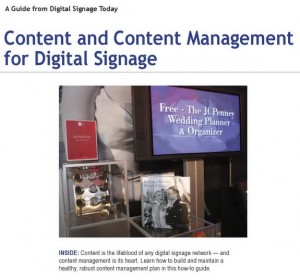DESIGNERS. Digital signage is quickly becoming a mainstream advertising medium. Simply look around in retail stores, shopping malls, arenas, gas stations, hotel lobbies, restaurants, and you’re likely to see one or more digital signs.
If you haven’t yet been asked to create content for digital signage, you may be soon. Digital signs are becoming more popular partly because they can display many more advertising messages (more content!) than a single, printed sign.
 Users of digital signs quickly learn that the quality and the creativity of the content on the sign really matters. In the foreword to an e-book on “Content and Content Management for Digital Signage,” Digital Signage Today editor James Bickers notes that the best digital signage hardware and software will fail spectacularly if used to deliver weak, boring, or poorly designed content.
Users of digital signs quickly learn that the quality and the creativity of the content on the sign really matters. In the foreword to an e-book on “Content and Content Management for Digital Signage,” Digital Signage Today editor James Bickers notes that the best digital signage hardware and software will fail spectacularly if used to deliver weak, boring, or poorly designed content.
To help ensure that your creative ideas will meet your client’s needs, the digital-signage experts at Keywest Technology have developed the following checklist to help marketing managers provide clear instructions when asking a designer to produce content for digital signage.
Clearly state what you wish to accomplish. Explain precisely how the signs are to be used. Will they be informational in nature? Do you want to sell a product or service with the signs? Is the communication mission straightforward like that of a menu board? Or is the mission more nuanced?
Define your target audience. Provide as much demographic and psychographic information about your intended viewers as possible What is the age range, sex, and ethnic background of the intended viewer? What are their interests, attitudes and opinions?
Identify where the signs will be located. Giving your creative team this information will inform decisions they make later about the appearance, placement and dwell time of content they will create.
Explain desired quality. In today’s world, it is hard to imagine that the display or displays to be used won’t be HDTVs. But even if that’s the case, will they be 720p, 1080i or even 1080p displays? That information will be helpful when content is created and may reduce the need for up, down or cross conversion of video, graphics and animation content.
Prevent visual spam. Because digital signage is becoming more common, the level of “visual noise” is also increasing. This should be considered along with the sensibilities of the target demographic. Work with designers to create a pleasing visual environment that will be more readily received by a discerning audience. Avoid excessive in-your-face content that may work against the shopping experience by overloading the senses. Too much eye candy is not a good thing –it can give eye pain.
Define duration. On a macro level, your messaging will be used for a finite period before it must be updated or changed entirely. On a micro level, individual pieces of content will dwell on the screen before being updated by the next item in the list. Provide duration information about both types of messaging. This will help your team create content that can accomplish its communications task in its allotted onscreen time, while building a workable schedule for producing future content.
Discuss the number of onscreen zones desired. Give your team a rough idea of how many discrete areas of onscreen real estate you envision being used to communicate your message. Suggest what you believe should be communicated in each zone. But don’t consider this the last word on the topic. Instead, use your initial vision as a starting point to discuss and ultimately define how many zones will actually be used.
Identify existing content resources. While you will want your content to be fresh, engaging and designed to meet your communications goals, there is no sense reinventing the wheel when existing resources can be used or repurposed. For example, if you plan to use a digital sign to communicate to owners of high-performance cars while they wait in a car dealer’s service area, you might consider using an existing RSS feed of Formula One, Indy Car and NASCAR race results and news for an onscreen crawl.
If you have worked on digital signage projects before, do you think this checklist is complete? Is there additional information you wish more clients would provide before you start working on a digital sign project?
Keywest Technology is a leading provider of interactive digital signage software and players. The company’s website includes a variety of case studies and white papers related to the many different uses of digital signs.
LINKS
White Paper: Content and Content Management for Digital Signage

